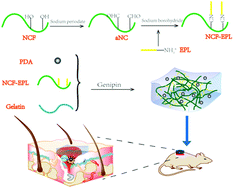A hydrogel based on nanocellulose/polydopamine/gelatin used for the treatment of MRSA infected wounds with broad-spectrum antibacterial and antioxidant properties and tissue suitability
Abstract
Most wound dressings encounter a series of problems when dealing with the bacterial infection of wounds, for example, the antibacterial and antioxidant capacities, comfort, and mechanical properties are not suitable to meet clinical requirements. Here, we synthesized ε-polylysine-grafted nanocellulose (NCF-EPL) and polydopamine (PDA) nanoparticles and embedded them in genipin-cross-linked gelatin to prepare a hydrogel (NCF-EPL/GTP/PDA). In this system, the embedded NCF-EPL and PDA interact with the gelatin matrix to form a hydrogel with excellent physical properties. The hydrogel has broad-spectrum antibacterial abilities and good antioxidant performance, and it can effectively promote cell proliferation. Full-thickness MRSA-infected skin wound healing experiments clearly show that the NCF-EPL/GTP/PDA hydrogel can significantly accelerate the healing of infected wounds via killing bacteria and reducing inflammation, and secondary damage caused by adhesion during dressing use is effectively avoided. In short, the hydrogel provides a new method for overcoming the shortcomings of traditional dressings, and this approach provides further solutions for the selection of clinical dressings for healing wounds.



 Please wait while we load your content...
Please wait while we load your content...